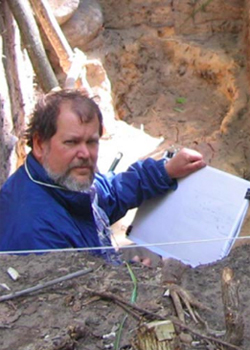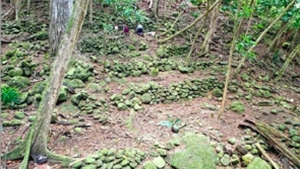
Ancient Hawaiian farmers may have used sophisticated engineering techniques to grow taro as far back as 800 years ago, according to research conducted by a University of Hawaiʻi at Mānoa team.
In July and August 2020, Department of Anthropology Professor Patrick V. Kirch, graduate students and Molokaʻi community volunteers spent five weeks on the Friendly Isle conducting an archaeological mission in Hālawa Valley. Archaeological surveys and excavations took place in two of the valley’s ʻili or traditional land sections.
“Some of the most interesting finds were made at two sets of stone-faced terraces that appear to have been irrigated from side-valley streams in Pualaulau and Kapana,” Kirch said. “These smaller field systems were not like typical loʻi (taro patches) found on the main valley floor, but rather were constructed in and around boulder fields, a remarkable kind of engineering.”
Kirch added, “From our excavations, it appears that the farmers who constructed these fields used a form of ‘hydraulic engineering’ to move sediments from the stream bed into the terraces, to build up soil that could then be planted in taro.”
The mapping revealed extensive sets of ancient agricultural terraces along with house sites and several agricultural heiau. Excavations yielded charcoal samples that are now being analyzed and radiocarbon dated, which will provide a chronology for the development of the valley’s agricultural system. Other samples are being analyzed for microscopic pollen, plant silica “skeletons” and starch grains to determine which crops were being grown.
Educational opportunity

The magnitude of the discovery was not lost on anthropology graduate student Kylie Tuitavuki, who is benefiting from the STEM training opportunity for Native Hawaiians and other underrepresented stakeholders in field settings.
“I am a big proponent of community-based archaeology, and strongly believe that research should be done with and for the people,” Tuitavuki said. “The archaeology part was great, but the stories, histories and connections we made with community members was the best part of the field season. I was excited to be able to work in the region where my family is from.”
Kirch’s team will continue its research in Hālawa Valley this year, with the goal of understanding how the ancient “hydraulic engineers” of Hawaiʻi created sustainable and productive agricultural systems that endured for centuries.
This research is an example of UH Mānoa’s goal to promote Excellence in Research: Advancing the Research and Creative Work Enterprise (PDF), one of four goals identified in the 2015–25 Strategic Plan (PDF), updated in December 2020.
Supporting Kirch’s work

Kirch’s work is supported by his longtime friend Debra Prentice. A UH Mānoa graduate student with research focused on Polynesian societies in the late 1970s when she met Kirch, Prentice said giving back to UH Mānoa during one of the most challenging years is testament to her lifelong interest in anthropology, her commitment to academic research and a friendship standing the test of time.
She and her husband recently established the Debra and Arlen Prentice Research Fund for Pacific Island Archaeology and Anthropology. Housed in the UH Foundation, their gift will support a graduate research assistant and discretionary expenses.
“Pat’s work is important,” Prentice said. “I firmly believe that in order to move forward and solve some of our challenges in today’s complex world, we need to understand our history, to know where we came from and how we got here. Prehistory can teach us so much.”
For more on Kirch’s work, Prentice’s generous contribution and additional stories visit the College of Social Sciences’ website.

